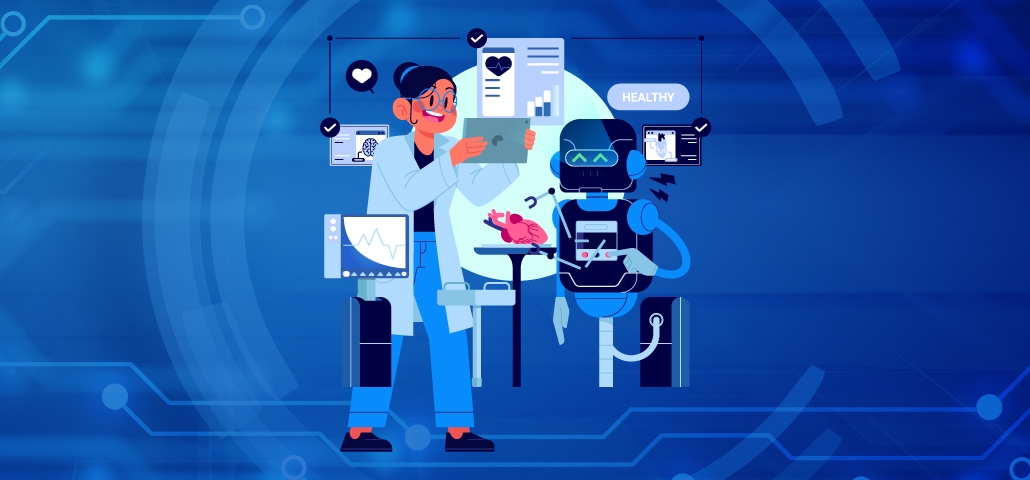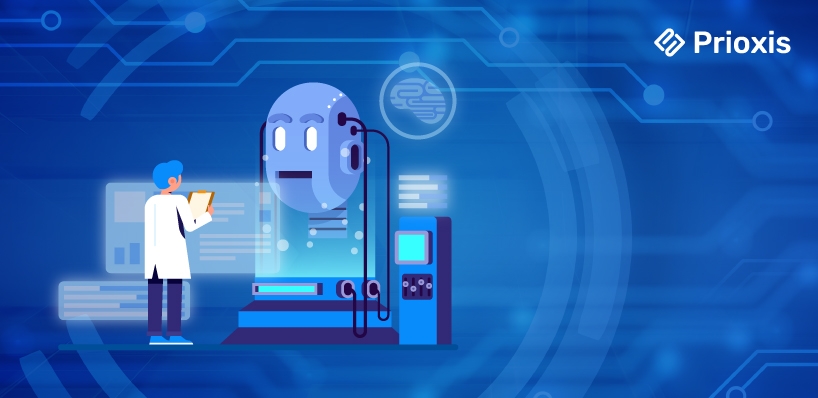
Table of Content
Healthcare industry is changing fast, and technology is playing a bigger role in that transformation every day. Hospitals are struggling to provide excellent care while also keeping an eye on costs, which isn't always easy.
That’s where Robotic Process Automation, or RPA, comes in. RPA is an AI-powered automation system that helps hospitals run more smoothly, reduces errors, and, most importantly, improves patient care.
In this blog, we will discuss how RPA is transforming processes in healthcare, what it is being used for, the benefits it offers, and what trends we will witness in the future.
Robotic Process Automation (RPA) is a technology that uses software solution to automate process that are repetitive, rule-based tasks traditionally handled by humans. These RPA bots interact with digital systems in much the same way that people do but with greater speed and accuracy. In healthcare, RPA is particularly useful for managing various administrative and operational tasks, from patient registration to claims processing, without requiring significant changes to existing IT infrastructure.
Healthcare providers have a lot on their plate—handling massive amounts of data, keeping up with strict regulations, and delivering top-notch patient care, all while trying to keep costs down. Doing everything manually can be slow and mistakes happen, which can lead to inefficiencies that impact patient care and drive-up costs. That’s where RPA comes in. By automating those routine, time-consuming tasks, RPA allows healthcare professionals to focus on what really matters—caring for patients.

RPA’s impact on healthcare goes beyond simple task automation. It significantly changes how hospitals and healthcare providers operate, driving improvements through automation and artificial intelligence, in both patient care and overall efficiency. It offer several benefits of RPA in healthcare. Here's a closer look at how RPA is making these changes:
Patient registration is often the first interaction between a patient and a hospital. Long wait times and paperwork can create a negative experience. RPA automates the registration process by quickly and accurately collecting and verifying patient information. This not only shortens wait times but also reduces the workload on administrative staff, leading to a more positive patient experience.
RPA handles pre-admission tasks, such as verifying insurance coverage and gathering medical history, ensuring that all necessary information is ready before the patient arrives. This leads to quicker admissions and allows healthcare providers to focus on delivering timely care.
Managing appointments can be complex, especially in large healthcare facilities. Missed appointments or scheduling conflicts can disrupt the care process and reduce the efficiency of healthcare providers. RPA automates appointment scheduling, sends reminders to patients, and manages cancellations and rescheduling. This ensures that healthcare providers’ time is used effectively, reducing wait times and improving patient care.
The automated management of appointment slots also allows hospitals to make the most of their resources, ensuring that every available slot is filled and reducing downtime for healthcare professionals.
Billing errors can lead to payment delays and disputes, negatively impacting a hospital's financial health. RPA automates billing and claims processing tasks, applying billing codes correctly and submitting claims accurately. This reduces the likelihood of human error, speeds up the reimbursement process, and improves financial outcomes.
RPA also automates the follow-up process for unpaid claims, ensuring that issues are addressed quickly, reducing the administrative burden on staff and increasing the overall efficiency of the billing department.
Accurate and up-to-date patient data is critical for effective treatment. RPA helps maintain patient records in real-time, integrating data from various sources such as electronic health records (EHRs), lab results, and imaging systems. This comprehensive approach to data management ensures that healthcare providers always have access to the information they need to make informed decisions, leading to better patient outcomes.
RPA enhances data security by automating access controls, ensuring that sensitive patient information is only accessible to authorized personnel, which is crucial for maintaining compliance with regulations such as HIPAA.
Compliance with healthcare regulations is essential, but it can be a time-consuming and complex process. RPA automates many of the tasks associated with compliance, such as generating reports, tracking regulatory changes, and ensuring that patient consent forms are properly completed and stored. By reducing the administrative burden associated with compliance, RPA allows healthcare providers to focus more on patient care.
Automating compliance-related tasks not only reduces the risk of non-compliance but also ensures that hospitals are always prepared for regulatory audits, minimizing potential disruptions to operations.
RPA enables healthcare professionals to focus on more meaningful work by automating routine, repetitive tasks. This improves job satisfaction and productivity, as staff can spend more time on patient care, research, and strategic planning rather than on administrative duties.
For example, nurses can focus more on direct patient care rather than spending time on paperwork, while doctors can dedicate more time to diagnosing and treating patients. This not only improves the quality of care but also enhances the overall efficiency of the healthcare facility.
RPA, combined with AI, can analyze large amounts of patient data to predict trends and optimize resource allocation. For instance, RPA can predict patient inflow trends, allowing hospitals to adjust staffing levels in anticipation of busy periods. This ensures that hospitals are always adequately staffed, reducing the risk of burnout among healthcare professionals and ensuring that patients receive timely care.
RPA can manage the inventory of medical supplies, predicting when certain items will run low and automatically reordering them, ensuring that hospitals are always well-stocked with the necessary materials without overstocking and wasting resources.
The ultimate goal of healthcare is to provide the best possible care to patients. RPA enhances the patient experience by making hospital visits more efficient and less stressful. From faster registration and shorter wait times to accurate billing and timely follow-ups, RPA touches every aspect of the patient journey, leading to higher satisfaction rates.
The use of RPA in patient communication—such as sending appointment reminders, providing updates on lab results, and offering post-treatment care instructions—ensures that patients feel informed and cared for throughout their healthcare journey.
Read More: Business Intelligence in Healthcare
RPA is like a helping hand for healthcare staff, taking over those repetitive tasks that can bog them down:
RPA improves how healthcare facilities handle their finances:
RPA helps maintain and manage digital patient records:
As RPA technology continues to evolve, healthcare providers can expect even more advanced applications. Future developments may include deeper integration with AI, enabling predictive analytics, personalized treatment plans, automation solutions. These advancements will further enhance hospitals' ability to deliver high-quality patient care while managing resources effectively.
Several hospitals have already implemented RPA with notable success:
The application of Robotic Process Automation (RPA) in healthcare provides numerous advantages that directly impact the efficiency, quality of care, and financial performance of healthcare organizations. Below are the key benefits tailored specifically to the healthcare industry:
In healthcare, the revenue cycle is a critical area where efficiency directly impacts financial health. RPA streamlines the entire revenue cycle, from patient intake to final payment, by automating billing, coding, and claims management processes. This reduces the turnaround time for claims submission, minimizes denials, and accelerates reimbursements. By ensuring accurate coding and timely claims processing, RPA helps healthcare organizations maintain a steady cash flow and reduce the financial losses associated with billing errors and delays.
Managing patient flow efficiently is crucial for maximizing the use of hospital resources and improving profitability. RPA improves patient throughput by automating scheduling, registration, and discharge processes. This ensures that beds are turned over quickly, reducing patient wait times and allowing hospitals to treat more patients without compromising care quality. By optimizing bed utilization and streamlining patient flow, RPA helps hospitals increase their capacity and revenue potential.
Healthcare organizations are subject to strict regulations that govern patient care, data security, and billing practices. Non-compliance can result in significant fines, legal action, and damage to reputation. RPA mitigates these risks by automating compliance-related tasks, such as generating audit reports, tracking changes in regulations, and ensuring adherence to data protection laws like HIPAA. This reduces the likelihood of human error in compliance processes and helps avoid costly penalties, protecting the organization’s bottom line.
Healthcare organizations often face high labor costs, particularly in administrative and clerical functions. RPA allows healthcare providers to reduce these costs by automating repetitive, time-consuming tasks that would otherwise require significant human resources. By reallocating staff to more strategic roles and minimizing the need for overtime or temporary workers, hospitals can control labor expenses and improve overall operational efficiency. This is especially valuable in environments where staffing shortages are a concern.
As healthcare organizations grow, they need to scale their operations without a proportional increase in costs. RPA provides the scalability needed to handle larger patient volumes, more complex billing processes, and increased regulatory requirements without requiring significant investment in additional staff or infrastructure. This scalability ensures that healthcare organizations can expand their services and patient base while maintaining control over operational costs.
In the business side of healthcare, timely and accurate data is critical for making informed decisions. RPA facilitates better decision-making by ensuring that data is captured, processed, and analyzed efficiently. Whether it’s financial data, patient outcomes, or operational metrics, RPA enables healthcare executives to access real-time insights, allowing them to make strategic decisions that improve profitability and patient care. This data-driven approach helps organizations stay competitive and responsive to market changes.
Patient satisfaction directly influences a healthcare organization’s reputation and patient retention rates. RPA enhances patient experience by reducing administrative burdens, leading to faster service and more personalized care. Satisfied patients are more likely to return to the same provider and recommend the facility to others, driving repeat business and increasing patient lifetime value. By improving patient retention and loyalty, RPA contributes to long-term revenue growth and a stronger market position.
At Prioxis, we specialize in delivering customized RPA solutions that address the unique needs of healthcare providers. Our team works closely with hospitals to identify key areas where automation can have the most significant impact, from improving patient care to optimizing operational efficiency. With our expertise in RPA, we help healthcare organizations implement automation strategies that deliver tangible results.
RPA is transforming the healthcare industry by improving patient care and making hospital operations more efficient. As automation technology continues to advance, the potential for RPA in healthcare will expand, providing new opportunities to improve patient outcomes, reduce operational costs, and streamline processes. Hospitals that adopt this technology are better positioned to meet the challenges of modern healthcare, delivering better care and improving overall efficiency.
Implementing RPA in your healthcare operations increases efficiency. Repetitive tasks, human error, and heavy workloads can drain resources and impact both employees and patients. RPA automates nearly any manual, repetitive task, reducing the need for human involvement. This approach improves operational efficiency, cuts costs, reduces errors, and empowers employees, all while enhancing patient care and experiences.
Automation powers seamless experiences across the healthcare sector. Explore how Prioxis RPA helps your healthcare organization do more with less.
Get in touch